Well over a year ago, Nvidia broke out its GTX 10-series graphics cards, and while the GTX 1080 was the top dog at the time, the more affordable GTX 1070 offered arguably the most attractive performance-per-dollar for PC gamers. A few things have changed since then. The GTX 1080 Ti launched in March 2017 and smashed on everything that preceded it. AMD got back into the high-end market with the RX Vega series, with the RX Vega 56 trading blows with the GTX 1070 across multiple benchmarks.
That leaves us wondering where the new GTX 1070 Ti fits in. Clearly, it's situated between the 1080 and 1070 in price; and as expected, it falls in line between the two in terms of performance. But above all else, it's the definitive GPU in the sub-$500 price tier.
Technical Details
Like all the other GPUs in Nvidia's 10-series, it uses the same Pascal architecture as the rest of the line that debuted in May 2016, although it's no slouch when it comes to high-end performance. The GTX 1070 Ti packs 2432 CUDA cores and 152 texture units, aligning itself closer to the GTX 1080, especially with the same base clock speed. The Ti does have the same boost clock as the original GTX 1070, but simple manual overclocking solves clock speed disparity.
All these GTX cards share the same GP104 graphics processor, 8GB of video RAM, and 256-bit memory bus width, but both the 1070 and Ti version have the same 8Gbps GDDR5 memory clock. When it comes to power draw, the 1070 Ti is the same as the 1080 with its 180-watt thermal design power (the maximum heat generation that the cooling system can handle). Note that the card limits itself to generating 94 degree celsius before downclocking to keep temperatures from reaching unsafe levels. Nvidia recommends that a system is equipped with at least a 500-watt power supply. One 8-pin connector powers the GTX 1070 Ti. For ports, you get three DisplayPort connectors, one HDMI, and one dual-link DVI.
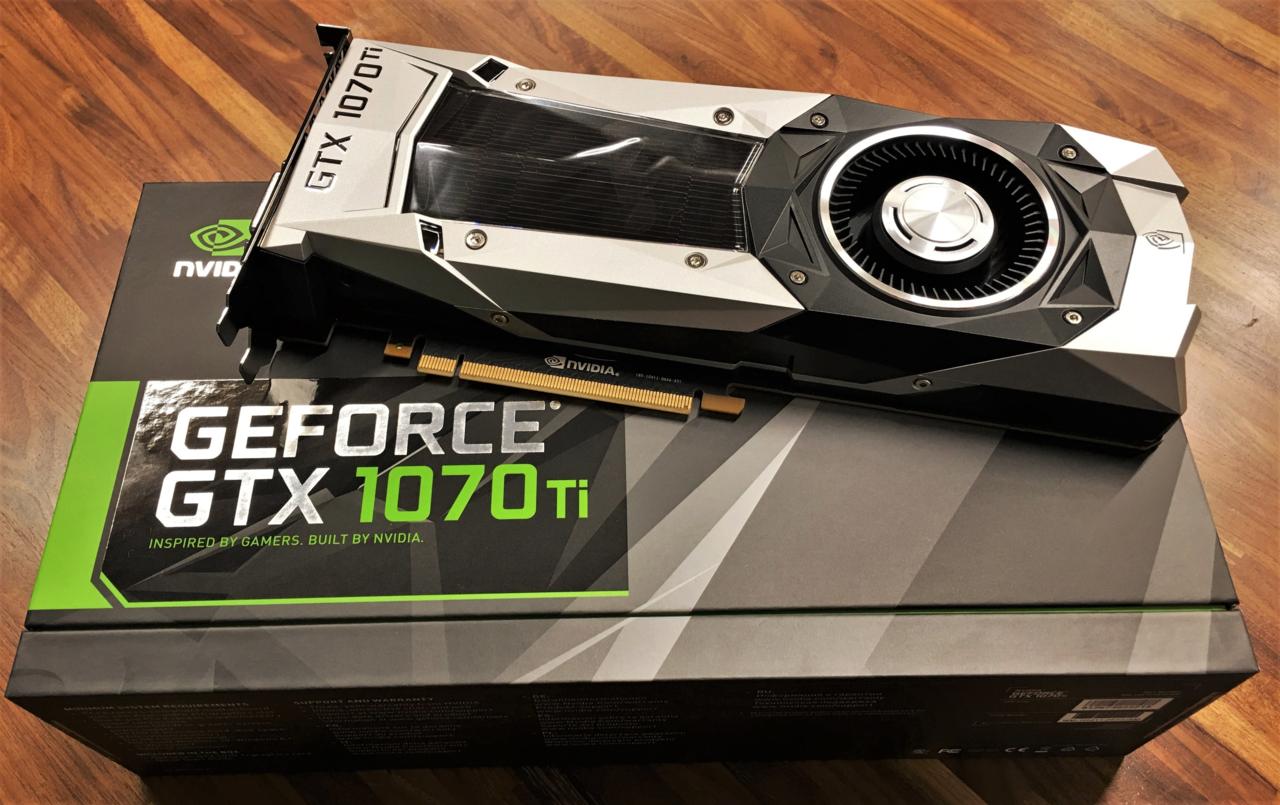
The particular model used for this review is the standard Founder's Edition, which is Nvidia's reference design. It features a single 30mm fan in a blower-style cooling solution with the same aluminum chassis and backplate seen in other Founder's Edition cards. Board partners (Gigabyte, ASUS, EVGA, MSI, PNY, Zotac) will offer various cooling solutions, physical styles, clock speeds, and prices. However, the suggested retail price for a GTX 1070 Ti is $450 USD.
| Nvidia GTX 1080 | Nvidia GTX 1070 Ti | Nvidia GTX 1070 | AMD RX Vega 64 | AMD RX Vega 56 | |
|---|---|---|---|---|---|
| CUDA Cores/Stream Processors | 2560 | 2432 | 1920 | 4096 | 3584 |
| Texture Units | 160 | 152 | 120 | 256 | 224 |
| ROPs | 64 | 64 | 64 | 64 | 64 |
| Core Clock | 1607MHz | 1607MHz | 1506MHz | 1274MHz | 1156MHz |
| Boost Clock | 1733MHz | 1683MHz | 1683MHz | 1546MHz | 1471MHz |
| Memory Clock | 10Gbps GDDR5X | 8Gbps GDDR5 | 8Gbps GDDR5 | 945MHz | 800MHz |
| Memory Bus Width | 256-bit | 256-bit | 256-bit | 2048-bit | 2048-bit |
| VRAM | 8GB | 8GB | 8GB | 8GB HBM2 | 8GB HBM2 |
| Transistor Count | 7.2B | 7.2B | 7.2B | 12.5B | 12.5B |
| TDP | 180W | 180W | 150W | 295W | 215W |
| Manufacturing Process | 16nm FinFET | 16nm FinFET | 16nm FinFET | 14nm FinFET | 14nm FinFET |
| GPU | GP104 | GP104 | GP104 | Vega 10 | Vega 10 |
| Launch Date | 5/27/2016 | 11/2/2017 | 6/10/2016 | 8/14/2017 | 8/14/2017 |
| Current MSRP* | $550 | $450 | $400 | $500 | $400 |
*Current MSRP does not reflect exact prices you would see on marketplaces and stores. Various board partners and retailers offer different prices.
Methodology
For our test bench, we used a system equipped with an Intel Core i7-5930X six-core CPU at 3.9GHz and 16GB of RAM in quad-channel. Although it's the same PC used in our previous tests in past reviews, we benchmarked some newer releases to get an idea of how these high-end graphics cards handle more graphically demanding games. We also used a few synthetic benchmarks like 3DMark 11, Unigine Valley, and SteamVR to provide a more rounded look at performance.
So, for the purposes of this review, we pitted the GTX 1080, GTX 1070, AMD RX Vega 64, and RX Vega 56 against the GTX 1070 Ti to get the best idea of how these similarly priced cards stack with one another.
Benchmarks
Rise of the Tomb Raider
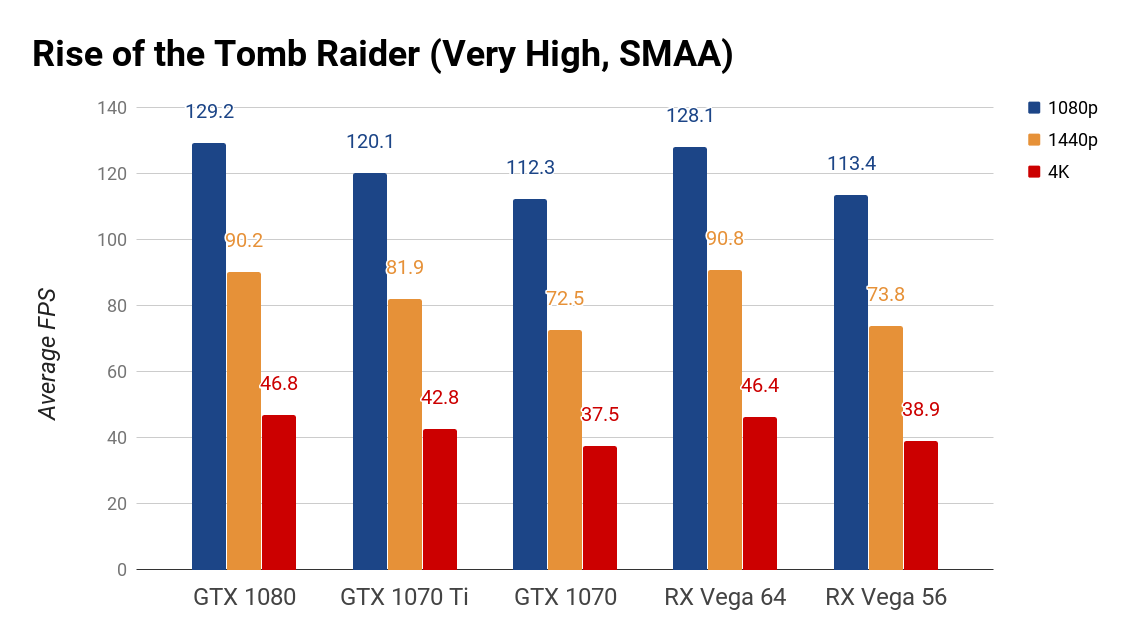
With Rise of the Tomb Raider, we used Very High graphics settings with SMAA in DirectX 12. Here we see the GTX 1070 Ti assert itself by outpacing both the GTX 1070 and RX Vega 56 in all resolutions. And it's no surprise that the GTX 1080 and RX Vega 64 pull ahead of everything else.
Metro: Last Light
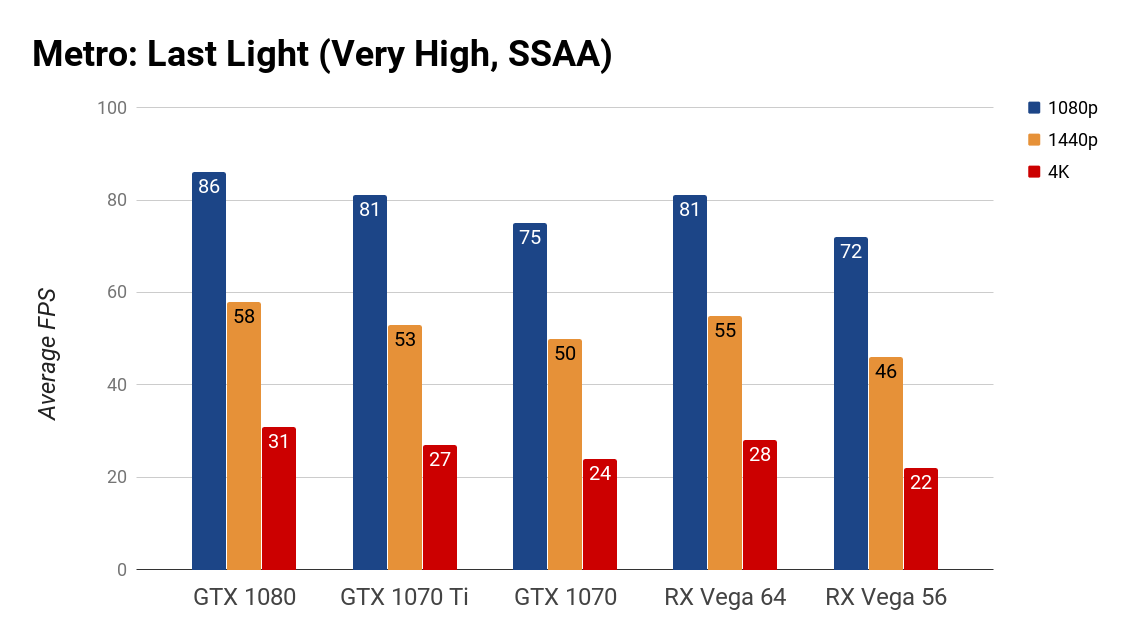
Metro: Last Light is one of the older games in our series of benchmarks, but it'll still tax your machine at max settings and SSAA on top. Sure, you can do without SSAA in 4K, but we wanted see how far we can push these cards. Not only was the GTX 1070 Ti able to beat out the 1070 and Vega 56, but it was neck-and-neck with the upper-tier RX Vega 64 and not straying too far behind the GTX 1080.
Middle-earth: Shadow of War
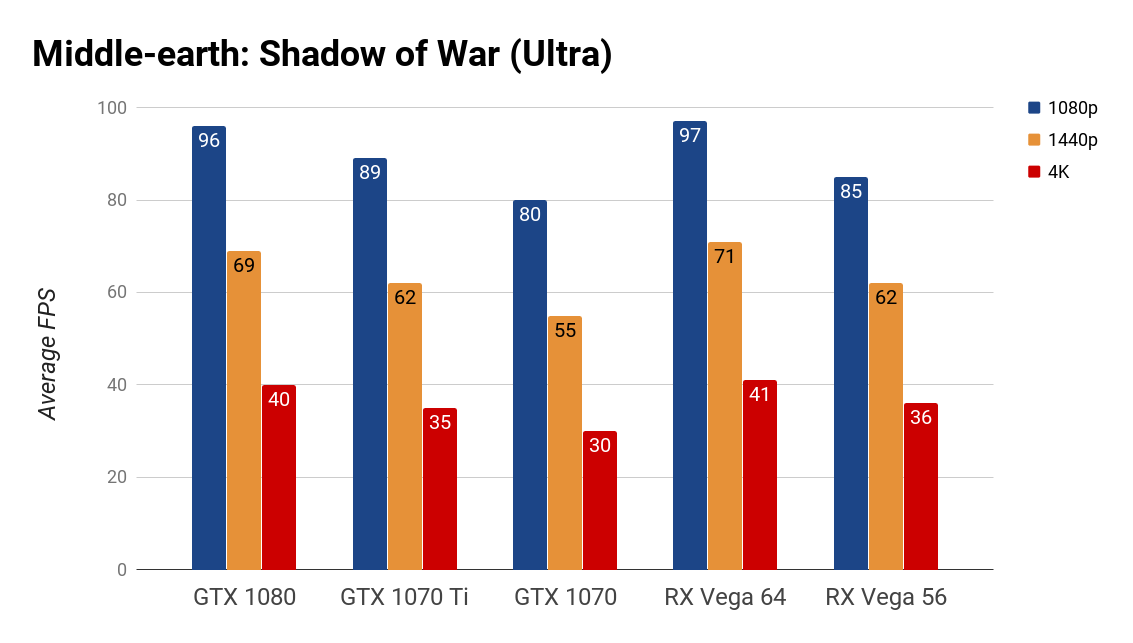
There's more parity between Nvidia and AMD cards in Middle-earth: Shadow of War when using the Ultra graphics preset. The GTX 1070 Ti offers a noticeable performance jump from its non-Ti counterpart, and its equidistant from the higher-tier GTX 1080. However, AMD's cards are able to keep up; the RX Vega 56 pretty much matches the 1070 Ti in all resolutions.
Grand Theft Auto V
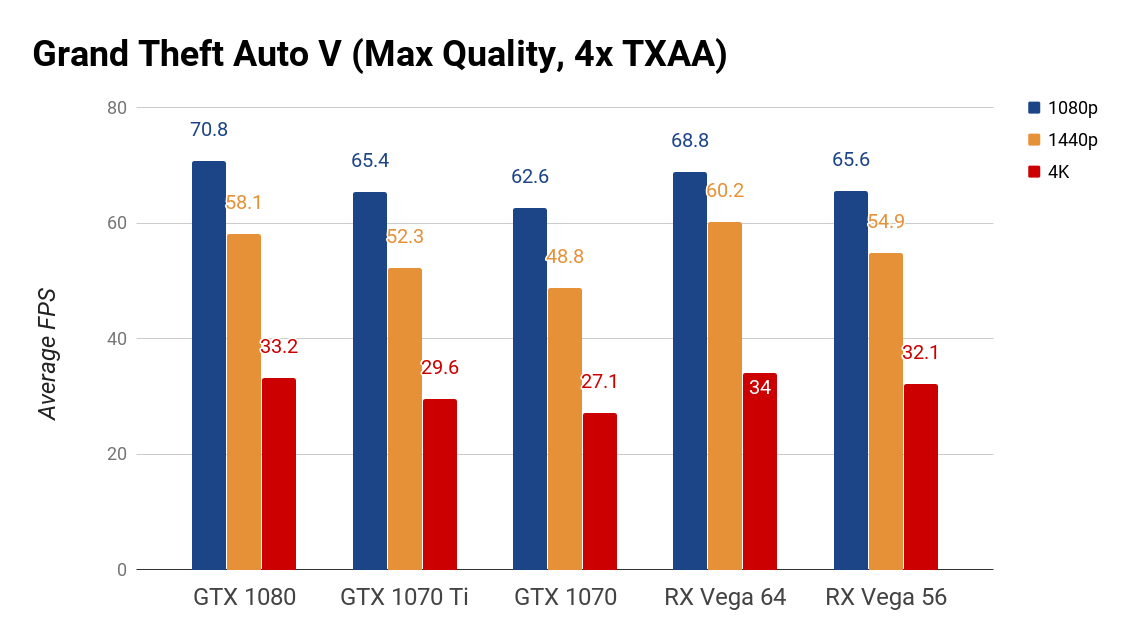
Performance in Grand Theft Auto V tells a trickier story. We cranked all the settings to the highest option including 4x TXAA, Nvidia PCSS soft shadows or AMD CHS shadowing (depending on the card), and extended distance scaling and shadowing to their fullest extent. AMD's cards performed admirably; the GTX 1070 Ti couldn't overtake the RX Vega 56, although the differences are quite miniscule. All cards have trouble distancing themselves from one another in our case.
Deus Ex: Mankind Divided
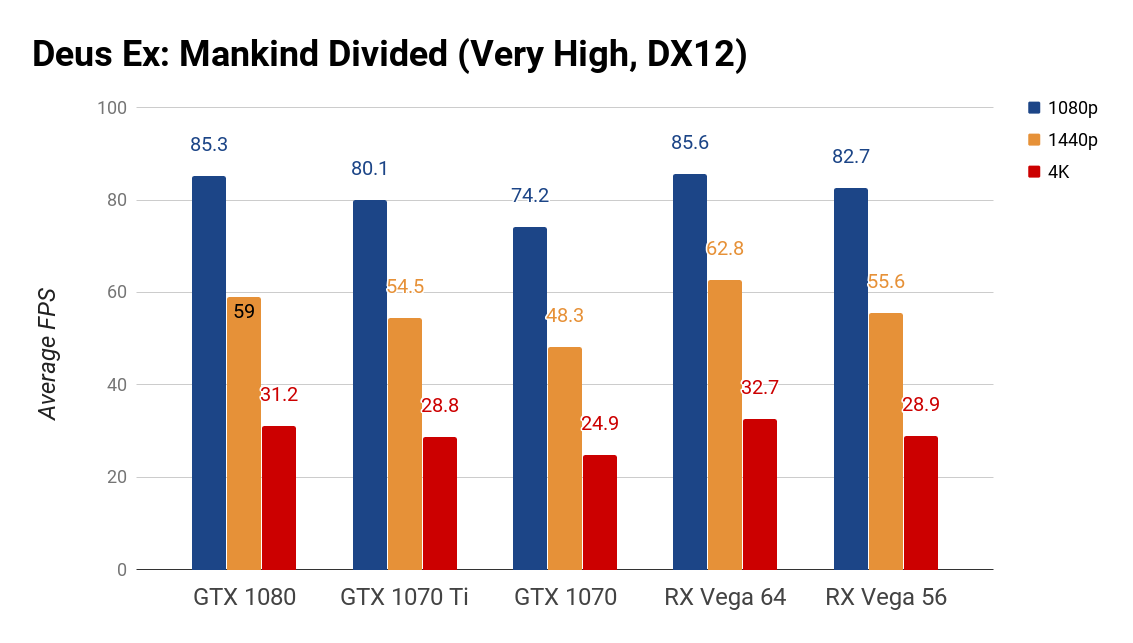
In another DirectX 12 test, Deus Ex: Mankind Divided offered favorable performance to AMD's video cards; the GTX 1070 Ti was edged out by the RX Vega 56 ever so slightly at each resolution. However, the Ti version is a substantial improvement over its non-Ti counterpart. These benchmarks were conducted with the Very High graphics preset in the options menu.
Ghost Recon: Wildlands
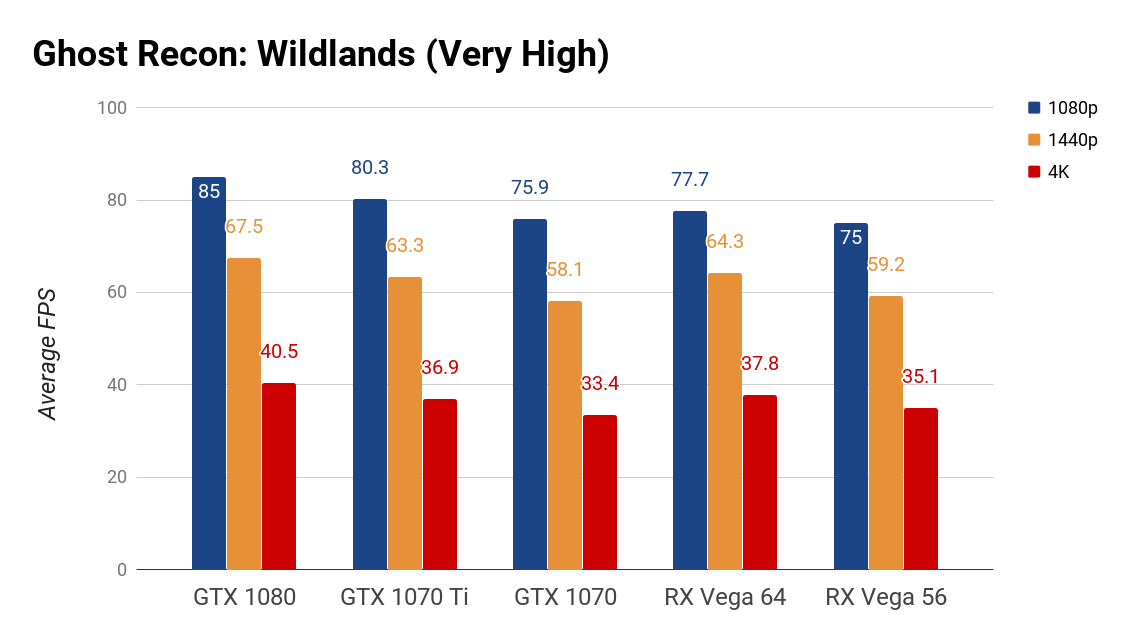
The GTX 1070 Ti shines in Ubisoft's Ghost Recon: Wildlands by staying well ahead of the non-Ti version and the RX Vega 56. It even keeps up with the RX Vega 64 at higher resolutions. For this game, we used the Very High graphics preset.
Unigine Valley
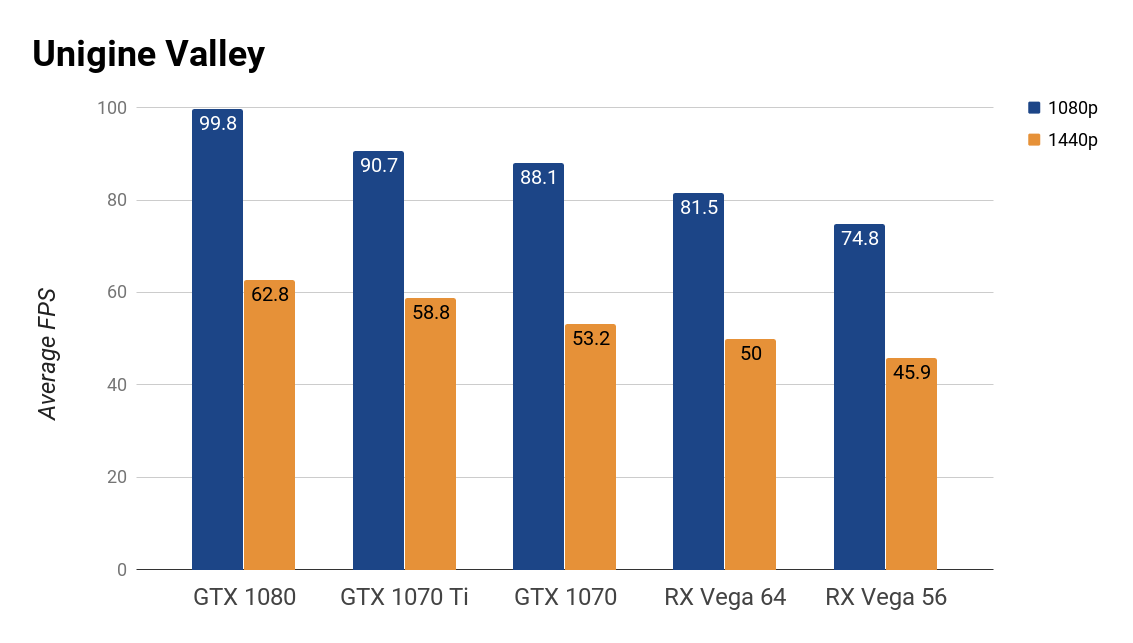
The Unigine Valley benchmark seems to favor Nvidia hardware substantially, given how wide the gap is between their AMD equivalents. At 1080p, the GTX 1070 Ti is hardly an upgrade over the non-Ti version but creates separation at 1440p.
3D Mark 11
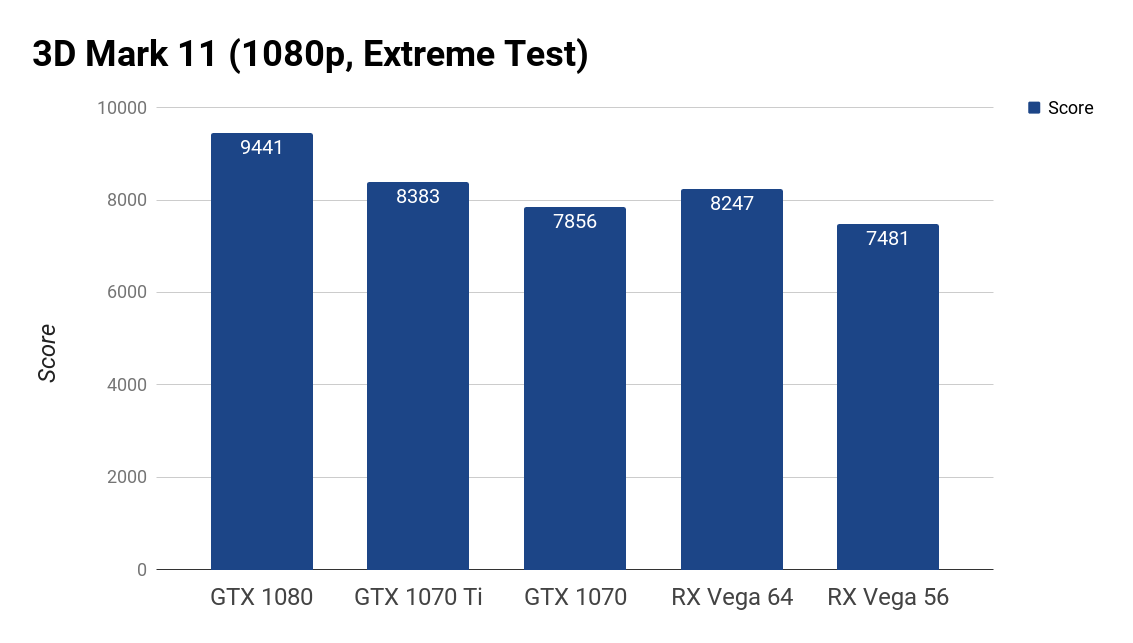
In 3D Mark 11's Extreme test, the GTX 1070 Ti stays ahead of both of AMD's RX Vega cards, but trails the GTX 1080 by a wider margin. It's a synthetic benchmark that tests several scenarios rendering 3D graphics and calculating CPU physics.
SteamVR
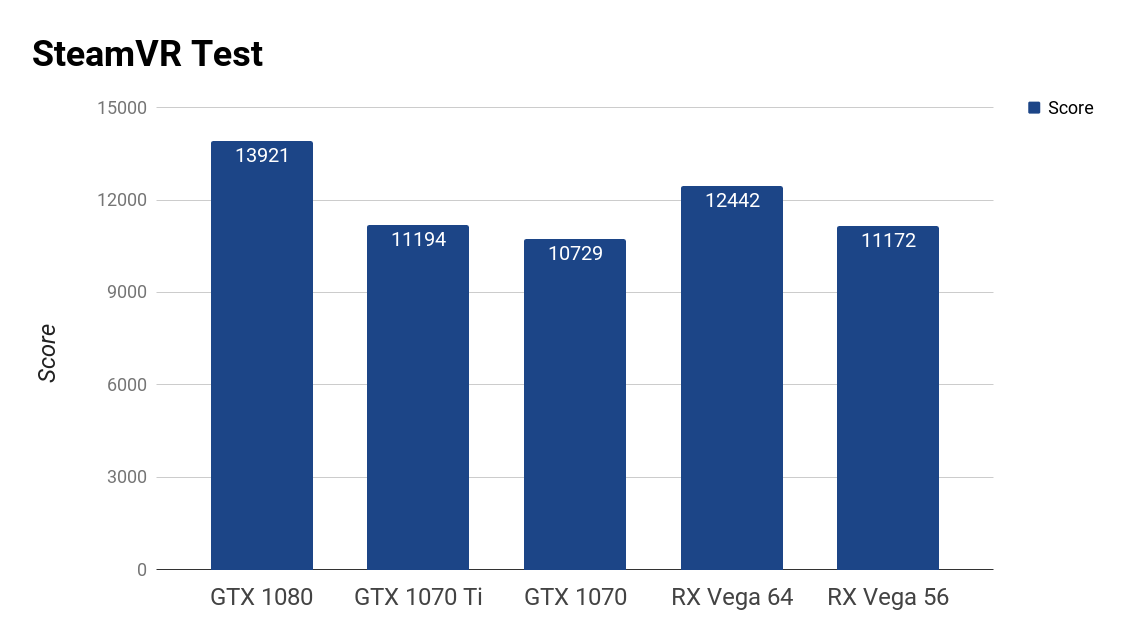
It's no surprise that the GTX 1070 Ti is more than capable to handle virtual reality applications of today. By scoring in the 10,000+ range, SteamVR deemed our system well-suited for VR gaming, just like the other Nvidia and AMD cards we have.
Temperatures
The GTX 1070 Ti sits at a mild 35 degrees C while idling. During peak load (running Ghost Recon: Wildlands at 4K), the card hit 82 degrees C, which isn't surprising for Founder's Edition of GP104 cards; the GTX 1080 would hit 83 degrees C and GTX 1070 would peak around 78 degrees C.
Verdict
The GTX 1070 Ti is as you would expect; the middle ground between the GTX 1070 and 1080 when it comes to gaming performance. In areas where AMD's RX Vega 56 overtakes the GTX 1070, the newly minted Ti version swoops in to at least match the AMD card, giving PC gamers another reason to consider an Nvidia card at this mid-to-high-end tier. It's not exactly intended for 4K gaming at high graphics settings, but it'd pair nicely with a high refresh rate 1080p or 1440p monitor since it puts out great numbers for those resolutions. And although we didn't test ultrawide 21:9 resolutions, the GTX 1070 Ti would go well for those using 3440x1440; it's a slightly higher performance demand than traditional 16:9 1440p (in which this card performed admirably), but isn't as grueling as 4K.
It's priced aptly at $450 USD, considering how close it performs to the GTX 1080, which is currently at $550 USD MSRP. This doesn't render AMD's RX Vega 56 obsolete since it's available at $400 USD MSRP, and there are number of FreeSync monitors that need to be paired with AMD hardware. Also note that actual market prices for these cards and their various versions are always changing. But as the GTX 1070 and Vega 56 trade blows in benchmarks, the slightly more expensive GTX 1070 Ti puts that matchup to rest. It's the best video card you can get under $500.







